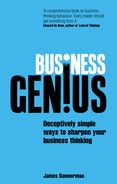The thirteenth Block and Limitation to Business Genius is a stifling organisational culture.
In other words, a culture where there’s very little wriggle room to think differently, let alone do things differently.
And what causes this? Bureaucracy? Office politics? Protocol?
Well, according to Harvard academic Teresa Amabile, it basically boils down to four things: too much surveillance, too much control, too much evaluation, and too many relentless deadlines.
By contrast, in the eyes of business author Robert Hartley, it boils down to three things: complacency (e.g. ‘We don’t need to change, because we’re fine as we are’), conceit (e.g. ‘We don’t need to change, because we’re better than everyone else’) and conservatism (e.g. ‘We don’t need to change because the old ways are the best’).
But let’s boil it down even further. Let’s boil it down to one thing.
‘You can’t do that here!’
Yes, I know it sounds crazily simple, but this one sentence ultimately sums up what a stifling culture is all about.
And here’s why.
According to innovation expert Jonne Ceserani – in his book Big Ideas: Putting the zest into creativity and innovation at work – there’s far more to this sentence than meets the eye because, depending on how one says it, it can mean five very different things:
‘You can’t do that here!’, for example, might well mean ‘I can do it, but you can’t (because I’m more powerful than you are),’ so the stifling issue in a business like this would be linked to structures, hierarchy and identity.
‘You can’t do that here!’ would be linked to beliefs and attitudes.
‘You can’t do that here!’ would be linked to capability and skills.
‘You can’t do that here!’ would be linked to behaviour.
And ‘You can’t do that here!’ would be linked to the environment.
And this is why it’s no coincidence that Business Genius moments are far more likely to flourish in a can-do culture where there’s plenty of permission to experiment, explore and excite – such as Pixar, Virgin, 3M, Innocent and Ben & Jerry’s ice cream – than in a you can’t do that here! culture, where there isn’t.
This doesn’t mean, however, that I’m suggesting you throw caution to the wind with your own business, and start to feel so liberated and creative that everything comes crashing down like a house of cards.
On the contrary.
I’m simply suggesting that a no mistakes culture (i.e. a culture where people can’t even make excusable mistakes, never mind inexcusable mistakes) is unlikely to spark innovative thinking and innovative solutions.
Besides, as Professor Robert I. Sutton of Stanford points out: ‘The best single question for testing an organisation’s character is: “What happens when people make mistakes?”’
Finally, however, please consider this: many organisations look upon efficiency as the key to success (and, in many instances, this may be so).
In Paul Sloane’s book The Leader’s Guide to Lateral Thinking Skills, however, he convincingly argues that innovation invariably beats efficiency time and time again because you could carry on making more and more efficient horse-drawn carriages (but then along comes the automobile), more and more efficient gaslights (but then along comes the electric light), or more and more efficient typewriters (but then along come electronic word processors).
Thinking better often matters in business. Yet thinking differently often matters more …


UP! YOUR INNOVATION CULTURE
NUGGET
When the Brazilian businessman Ricardo Semler took over his father’s business in 1981, he wasn’t that interested in doing things differently; he wanted to do things totally differently!
As a result, the industrial equipment manufacturer he inherited (called Semco) soon developed into one of the most innovative organisational cultures on the planet:
- ‘Workers made the decisions previously made by their bosses.’
- ‘Managerial staff set their own salaries and bonuses … without strings.’
- ‘Everyone was given access to the company books.’
- ‘Shop floor workers set their own productivity targets and schedules.’
Now, I’m not suggesting every company does a Semco. Far from it.
The reason I’m including this nugget is simply to highlight how – if business success is anything to go by – Semler’s approach wasn’t perhaps as crazy as it seemed.
In Semler’s book Maverick!: The success story behind the world’s most unusual workplace, for example (which was first published in 1993) his unorthodox approach went on to help the business grow eleven-fold, which was incredible, bearing in mind that inflation in Brazil back then was running at 900 per cent!
Not only this, however; it meant that they had 2,000 people on their waiting list who were longing to join, including hundreds who said they would take any job just to work there.
So what was the innovative idea behind all this? Well, Semler writes how it was simply ‘To make people look forward to coming to work in the morning …’ and, let’s face it, any business leader who can achieve that with their employees has to be a Genius!


USEFUL TIPS AND
ESCAPE STRATEGIES
So, if you want to UP! your innovation culture, here are three practical tips and strategies that can help:
1 PROVIDE ‘PSYCHOLOGICAL SAFETY’
Years ago, I was doing some consulting work for a large organisation in London when I walked past their spanking new, state-of-the-art creativity zone. It looked fantastic. Colourful beanbags, plenty of games and ideas stimulus, and it even had wacky ornaments dangling from the ceiling. ‘Why is no one in there?’ I asked. ‘Oh,’ I was told, ‘you wouldn’t be seen dead in there. People would think you’re not working!’
This insight led me to develop what I call the platinum rule of business innovation, which is this:
People need to feel safe enough to stop playing it safe
Yes, it’s a paradox, but the underlying principle is an important one.
Fear and creativity don’t mix!
And the reason they don’t mix – according to very clever people who walk around in white coats – is because they involve completely different brainwaves.
If someone is incredibly focused on something, for example (like sitting an exam, or meeting a deadline), brainwaves called Beta brainwaves kick in. These look a little like the short, jagged glass you might see on brick walls to deter burglars and, in terms of neuroscientific gobbledegook, their wave frequencies are between 14–40 Hz. By contrast, if that same person was fast asleep and totally relaxed, Delta brainwaves (i.e. less than 4 Hz) would emerge, which look a little like the large, rolling hills found in the Lake District.
The ones in between, however, (i.e. Alpha and Theta brainwaves, which are between 4 Hz and 14 Hz) are the ones most closely connected with creative thinking, as well as daydreaming and meditation, etc.
What this means is that we invariably come up with our best ideas when we’re focused (but not over-focused) and relaxed (but not over-relaxed), which is why Dickens got his best ideas going for a long walk, J. K. Rowling from sitting in a café, Edward de Bono whilst shaving.
Here’s the point, however.
If we work in a climate of fear (e.g. where we’re permanently worried about what our boss will say, or whether we’ll still have a job tomorrow) Beta brainwaves will naturally take over. And what does this mean? It means we go into emergency thinking, which means we focus on what works (because it’s worked before), and this means … goodbye creativity!
2 NURTURE OTHERS’ GENIUS
I recently asked a group – I was running a Lateral Thinking seminar – ‘What’s the one word that kills creativity more than anything else in business?’ (expecting them to say ‘But’, or something like that). Someone, however, simply said, ‘Manager!’ I thought it was a joke, but it then transpired that their manager even had a nickname which was Dr No (because they were always saying ‘No’ to everything). Anyway, I’m not saying this to be unkind. I’m saying it because often a manager is not deliberately trying to crush the creativity of others; they’ve simply never been shown how not to kill it. So, with this in mind, here’s an effective three-step process, which business trainer Julie Hay recommends, that can help:
- Paraphrase. So, if someone at work approaches you with their Business Genius idea of painting all the blue boxes red, simply feed back what you’ve heard, for example, say: ‘So your idea is to paint the blue boxes red.’ (This will demonstrate that you’ve been listening !).
- Praise. There is virtually always something positive (or potentially positive) about an idea, even though you might have to dig hard to find it. In this case, go on to say something like: ‘That definitely sounds innovative, and it would help us to differentiate them from the yellow ones.’
- Here’s the crucial bit, position. In other words, if the nagging thought at the back of your mind is, ‘No way! We can’t afford it!’, instead of saying that – which will flatten their inventiveness – find a way to reposition the same message to avoid doing more harm than good. For example, say: ‘Have you any ideas on where we might be able to find a budget for this?’
Using this approach often has two key benefits: on the one hand it encourages them to use their creativity to fix the potential problem, because they may be able to go away and find a budget for it, if they move a few things around; on the other, it means that they’re more likely to come to you with their next Business Genius idea, which might end up being the real winner!
3 REVEL IN VARIETY
The culture of Renaissance Florence was, arguably, one of the most innovative cultures of all time. Why? Because in Renaissance times it was perfectly normal for people like Leonardo Da Vinci to be polymaths (variety-seekers who were not only painters and sculptors, but also scientists, musicians and architects, etc.). If you want your culture to be more innovative, remember that innovation often evolves out of the rich cross-fertilisation of different people, from different departments, who have different perspectives and ideas.

BUSINESS GENIUS IN ACTION:
NEXT STEPS …
In summary, if you want to UP! your innovation culture, here’s how:
- Pinpoint effective ways to create wriggle room in your culture (because without it people’s Business Genius will soon become stifled by an endless barrage of, ‘You can’t do that here!).
- Investigate how other businesses have managed to excel in this area (from Pixar to Virgin and 3M to Innocent, to spark your own innovative thinking and innovative behaviours).
- Leverage the power of permission (remembering the platinum rule of business innovation: ‘People need to feel safe enough to stop playing it safe’).
- Orchestrate a plan for nurturing the Business Genius of others (for it could be that all the breakthrough ideas you’re looking for are locked inside the minds of those you work with, just waiting to be released).
- Target infinite variety (because – like the polymaths of Renaissance Florence – an innovation culture often stems from the rich cross-fertilisation of different perspectives and different ideas).
